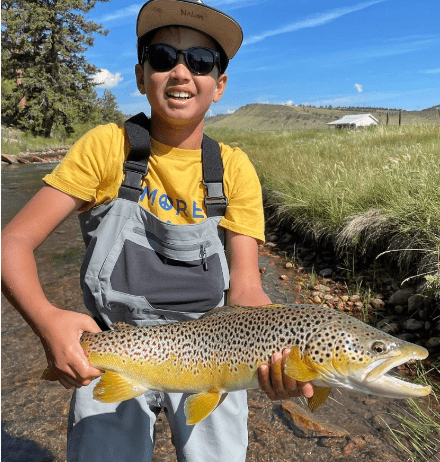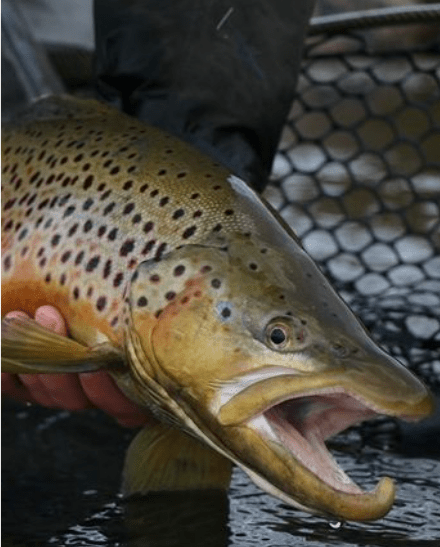Brown Trout Information
Colorado Brown Trout
Brown Trout (Salmo trutta) are a highly prized trout species among anglers in Colorado. Known for their elusive nature and strong fighting ability, Brown Trout provide a thrilling fly fishing experience in the state's rivers, streams, and lakes.
Identification:
In Colorado, Brown Trout are recognized by specific characteristics that set them apart from the other trout. They have a notable adipose fin located between the dorsal and tail fin. Their coloration ranges from olive green to golden brown on their back, transitioning to a lighter shade on their sides and belly. These trout are marked with dark red or black spots, often accompanied by faint halos. The lower fins of Brown Trout in Colorado may exhibit hints of red or orange.

Habitat:
Throughout Colorado, Brown Trout inhabit a variety of habitats. They flourish in wide rivers and smaller mountain streams, frequently seeking shelter in undercut banks, fallen trees, and deeper pools. Brown Trout exhibit remarkable adaptability and can withstand diverse water temperatures and conditions, making them excellently suited to the various aquatic ecosystems found in Colorado..
Behavior:
Brown Trout are known for their wariness and selective feeding habits, making them a challenging target for anglers. They primarily feed on aquatic insects, small fish, crustaceans, and terrestrial insects that fall into the water. Brown Trout are more active during low-light conditions, such as early mornings and evenings, and they often seek cover during the day. They are known to be more cautious and require a stealthy approach when presenting flies.
Spawning:
During the autumn season in Colorado, Brown Trout engage in spawning activities, typically from October to November. The precise timing of their spawning can be influenced by water temperature and environmental conditions. It is crucial to recognize the sensitivity of Brown Trout during this critical period. Many anglers opt to release the fish they catch or avoid fishing in their spawning areas, promoting the conservation and preservation of their populations.
Seasonality:
Brown Trout can be targeted year-round in Colorado, but their behavior and feeding patterns may vary with the seasons. During spring and fall, Brown Trout become more active and aggressive in feeding as they prepare for spawning or replenishing energy reserves. In the summer, they may seek more relaxed, deeper areas during the day's heat and become more active during the more excellent hours.

Fishing Tips
To increase your chances of success when fly fishing for Brown Trout in Colorado, consider the following tips:
- Fly Selection:Brown Trout are known to be selective feeders, so having a diverse selection of fly patterns is essential. Match the hatch by using flies that imitate the prevalent insects in the area. Effective dry flies include Elk Hair Caddis, Stimulators, and Parachute Adams. Nymph patterns such as Pheasant Tail, Hare's Ear, and Copper John can also be productive.
- Stealth and Approach:Brown Trout are easily spooked, so a stealthy approach is crucial. Wear earth-toned clothing to blend with the surroundings, move slowly and quietly along the water's edge, and avoid casting shadows over the fishing area. Stay low and make delicate presentations to prevent alarming the fish.
- Presentation and Accuracy:Brown Trout can be found in various water conditions, from fast-flowing riffles to calm pools. Tailor your presentation to the specific water type. Make accurate casts, as Brown Trout tend to scrutinize flies more closely. Present your fly upstream or across the current, allowing it to drift naturally.
- Experiment with Different Techniques:Brown Trout can be enticed by various fishing techniques. Consider trying different methods, such as dry fly fishing, nymphing, or streamer fishing, to see what works best on a given day. Adapt your approach based on the trout's feeding behavior and the prevailing conditions.
- Conservation and Catch-and-Release:Brown Trout populations in some areas are sensitive, so practicing catch-and-release is essential for their conservation. Handle the fish gently, use barbless hooks to minimize injury, and release them promptly to ensure their survival and the preservation of the fishery.
You can enhance your fly fishing by understanding the unique characteristics, habitat preferences, and feeding behavior of Brown Trout in Colorado.
